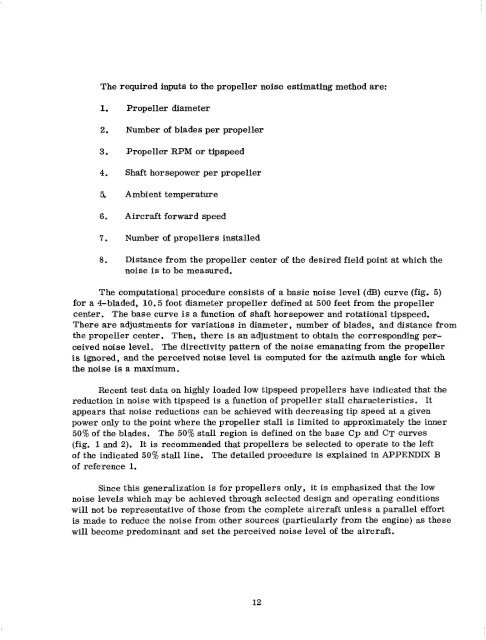COMPUTER PROGRAM USER'S MANUAL FOR ... - CAFE Foundation
COMPUTER PROGRAM USER'S MANUAL FOR ... - CAFE Foundation
COMPUTER PROGRAM USER'S MANUAL FOR ... - CAFE Foundation
You also want an ePaper? Increase the reach of your titles
YUMPU automatically turns print PDFs into web optimized ePapers that Google loves.
The required inputs to the propeller noise estimating method are:<br />
1. Propeller diameter<br />
2. Number of blades per propeller<br />
3. Propeller RPM or tipspeed<br />
4. Shaft horsepower per propeller<br />
5 Ambient temperature<br />
6. Aircraft forward speed<br />
7. Number of propellers installed<br />
8. Distance from the propeller center of the desired field point at which the<br />
noise is to be measured.<br />
The computational procedure consists of a basic noise level (dB) curve (fig. 5)<br />
for a 4-bladed, 10.5 foot diameter propeller defined at 500 feet from the propeller<br />
center. The base curve is a function of shaft horsepower and rotational tipspeed.<br />
There are adjustments for variations in diameter, number of blades, and distance from<br />
the propeller center. Then, there is an adjustment to obtain the corresponding per-<br />
ceived noise level. The directivity pattern of the noise emanating from the propeller<br />
is ignored, and the perceived noise level is computed for the azimuth angle for which<br />
the noise is a maximum.<br />
Recent test data on highly loaded low tipspeed propellers have indicated that the<br />
reduction in noise with tipspeed is a function of propeller stall characteristics. It<br />
appears that noise reductions can be achieved with decreasing tip speed at a given<br />
power only to the point where the propeller stall is limited to approximately the inner<br />
50% of the blades. The 50% stall region is defined on the base Cp and CT curves<br />
(fig. 1 and 2). It is recommended that propellers be selected to operate to the left<br />
of the indicated 50% stall line. The detailed procedure is explained in APPENDIX B<br />
of reference 1.<br />
Since this generalization is for propellers only, it is emphasized that the low<br />
noise levels which may be achieved through selected design and operating conditions<br />
will not be representative of those from the complete aircraft unless a parallel effort<br />
is made to reduce the noise from other sources (particularly from the engine) as these<br />
will become predominant and set the perceived noise level of the aircraft.<br />
12

















